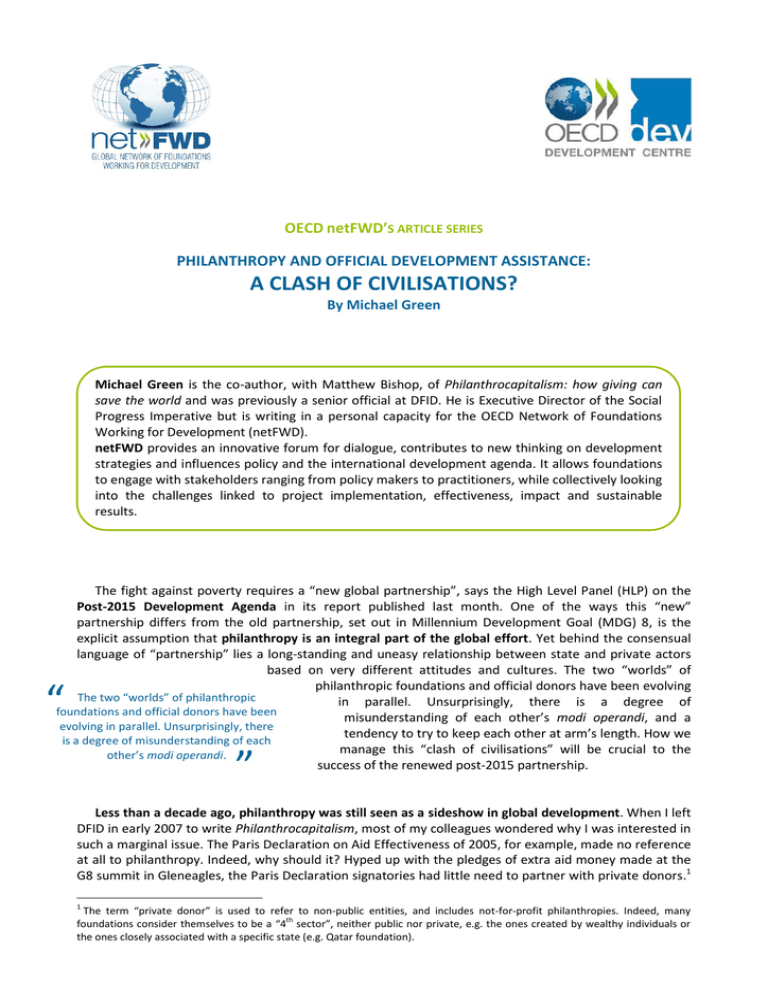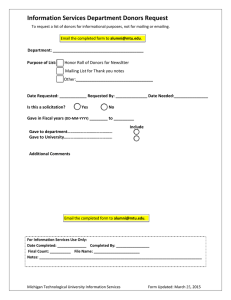A CLASH OF CIVILISATIONS? OECD netFWD’
advertisement

OECD netFWD’S ARTICLE SERIES PHILANTHROPY AND OFFICIAL DEVELOPMENT ASSISTANCE: A CLASH OF CIVILISATIONS? By Michael Green Michael Green is the co-author, with Matthew Bishop, of Philanthrocapitalism: how giving can save the world and was previously a senior official at DFID. He is Executive Director of the Social Progress Imperative but is writing in a personal capacity for the OECD Network of Foundations Working for Development (netFWD). netFWD provides an innovative forum for dialogue, contributes to new thinking on development strategies and influences policy and the international development agenda. It allows foundations to engage with stakeholders ranging from policy makers to practitioners, while collectively looking into the challenges linked to project implementation, effectiveness, impact and sustainable results. The fight against poverty requires a “new global partnership”, says the High Level Panel (HLP) on the Post-2015 Development Agenda in its report published last month. One of the ways this “new” partnership differs from the old partnership, set out in Millennium Development Goal (MDG) 8, is the explicit assumption that philanthropy is an integral part of the global effort. Yet behind the consensual language of “partnership” lies a long-standing and uneasy relationship between state and private actors based on very different attitudes and cultures. The two “worlds” of philanthropic foundations and official donors have been evolving The two “worlds” of philanthropic in parallel. Unsurprisingly, there is a degree of foundations and official donors have been misunderstanding of each other’s modi operandi, and a evolving in parallel. Unsurprisingly, there tendency to try to keep each other at arm’s length. How we is a degree of misunderstanding of each manage this “clash of civilisations” will be crucial to the other’s modi operandi. success of the renewed post-2015 partnership. “ ” Less than a decade ago, philanthropy was still seen as a sideshow in global development. When I left DFID in early 2007 to write Philanthrocapitalism, most of my colleagues wondered why I was interested in such a marginal issue. The Paris Declaration on Aid Effectiveness of 2005, for example, made no reference at all to philanthropy. Indeed, why should it? Hyped up with the pledges of extra aid money made at the G8 summit in Gleneagles, the Paris Declaration signatories had little need to partner with private donors.1 1 The term “private donor” is used to refer to non-public entities, and includes not-for-profit philanthropies. Indeed, many th foundations consider themselves to be a “4 sector”, neither public nor private, e.g. the ones created by wealthy individuals or the ones closely associated with a specific state (e.g. Qatar foundation). Yet those hopes of plentiful official aid flows were dented by the fiscal crisis that followed from the financial crisis of 2008 and the search was on for new ways to finance development and to complement Official Development Assistance. Hence, when the OECD Development Assistance Committee met again in Busan in 2011, “philanthropy” had made its way into the communiqué, at least on paper. The G20 went a step further that same year and even got a philanthropist, Bill Gates, to write a report on how to finance the MDGs. It is only natural that philanthropists welcomed this belated recognition of the contribution that they make to global development with lukewarm enthusiasm. What has evidently driven the eagerness of official donors for the “new global partnership” is much less an interest in the innovative ways that philanthropic organisations operate, and much more the need from the official development community to find new forms of financing. Ergo, the sitting on the fence of some prominent foundations engaged in development, which did not feel compelled to join this “donor club”. The incentives were just not there…. To understand what the new global partnership means from the official donors’ perspective, a 2011 article by Kevin Watkins2 is highly instructive.3 Mr. Watkins’ paper, written for the Rockefeller Foundation funded Bellagio Initiative, offers a pretty jaundiced view of philanthropy’s contribution to education. Happily, he provides a guide to good etiquette for private actors arriving late to the global development party: 1) Strengthen the multilateral aid architecture; 2) Work through governments; 3) Get active on advocacy. This is all good solid stuff for those raised and fed by the principles of the Paris Declaration. But the message to philanthropists is an unappealing one: give your money through the existing aid channels, desist from running your own programmes, and help drum up support for more taxpayers’ money for official donors to spend. This is the fatal cultural flaw to much of the official donors’ approach to what should be a new global partnership: the sense that they have nothing to learn from philanthropists and a desire to protect the sacred principles of the Busan Partnership for Effective Development Co-operation at all costs. “ Yet the fault does not lie with official donors alone. Too many private donors remain ignorant of even the existence of the MDGs. Too few have much idea about how the official aid system works or that there is already an “ecosystem” in place that they should be aware of when they get involved on the ground. Indeed, philanthropic The belief that what private donors “exceptionalism”, the belief that what private donors do is do is necessarily good and that necessarily good and that what official donors do is necessarily what official donors do is inefficient and bureaucratic, is all too prevalent. The fight against necessarily inefficient and poverty will not be won with such evidence-free assertion and bureaucratic, is all too prevalent. simplistic dichotomies. Philanthropists have also, regrettably, lagged behind official donors in embracing the culture of transparency, data sharing and accountability to beneficiaries and to the governments of the countries in which they operate. What I hear from many foundations is that this is “unnecessary bureaucracy”, suggesting an unwillingness to ” 2 Kevin Watkins is the new head of the UK’s Overseas Development Institute (ODI) but was then a champion of the “Education for All” Project. 3 http://www.bellagioinitiative.org/wp-content/uploads/2011/11/Kevin-Watkins-Corporate-summary_final.pdf recognise that changing the world is a team game and that they need to play ball if they want to have impact and scale up the innovations they have worked hard to bring to life. These are, of course, generalisations. Some notable exceptions include the Rockefeller or the Bill and Melinda Gates Foundations, which have built strong partnerships with official donors (and, for that reason, inspired much of the thinking about a new global partnership) and have been able to engage with governments in developing countries. The Gates Foundation has even been reporting its aid spending to the OECD DAC since 2011.4 Their considerable resources, of money and its founder’s public profile, mean that it can negotiate on equal terms with governments. Its budget is even greater than that of World Health Organisation (WHO). Yet, Mr. Gates acknowledgement that even his philanthropic behemoth is merely “a tiny, tiny organisation”5 compared to the challenges it is taking on reflects that foundations just cannot do it alone. However, the power relations might vary based on whether you are a world-known philanthropist or a smaller and lower profile foundation. Other philanthropic organisations have more reason to worry that partnership means getting bossed around. So what should the new global partnership look like? I would suggest three “rules of engagement”: First, there needs to be joint decision-making and shared governance. Official donors cannot expect philanthropic organisations to stump up cash without a seat at the table. The Global Three “rules of engagement”: Fund to Fight AIDS, Tuberculosis and Joint decision-making and shared governance Malaria was an important Partnership around specific issues innovation in this regard: by giving Understanding the division of labour private donors and business seats on the board it became much more attractive to a philanthropist than, say, giving a grant to the WHO over which the donor will have little say. Like it or not, we will need to see more of these unconventional funding mechanisms and issues-based partnerships for global development rather than expecting all new financing to flow through existing channels (and especially through bilateral donors’ programmes). Second, partnership works best around specific issues. Like it or not, success breeds success, so if philanthropic organisations can see their money leading to concrete results and having tangible (measurable) impact, it is more likely to inspire further donations (from big and small donors). The Malaria No More campaign is instructive here as a successful partnership between official and private donors. That partnership is forged around an easily understandable problem, against which headway can be made in real time that can be attributed to the interventions funded. Some worry that focusing on success in this way distorts the global development agenda towards quick wins or more “media friendly” issues. Well, maybe. Suggesting that official development assistance is immune from faddishness or the influence of what taxpayers might find “sexy” is, frankly, a bit of a stretch. Whether you like it or not, finding jobs for the unemployed youth in Africa, or getting access to quality education is more likely to attract funding and attention than statistical capacity building. Moreover, having an eye to public opinion in donor countries and demonstrating success is going to be increasingly important in these straitened fiscal times. Third, understanding the division of labour. The reason I am optimistic about the potential of the new global partnership is that philanthropy can do things that official donors cannot. A philanthropic dollar and an ODA dollar are very different things. Rather than trying to fill the funding gap in existing official donor programmes, philanthropy should play the role of innovative “ ” 4 For the first time in 2011, the OECD’s Development Assistance Committee (OECD DAC) included in its aid data grants made by the Bill & Melinda Gates Foundation in support to global health. The Gates Foundation’s investments in health could then be compared with and added to figures for official donors and multilateral organisations – a significant step for both the OECD DAC and the Gates Foundation in their shared goal of attaining greater transparency in aid reporting. 5 Ref: “Philanthrocapitalism”. risk capital in development, testing new ideas that can be scaled by official donors in collaboration with partner governments and local organisations. This is already happening to some degree, such as the partnership between USAID and the Skoll Foundation on the Development Innovation Ventures programme,6 but is not yet mainstream. “Nation states will remain the most powerful actors in world affairs”, wrote Samuel Huntington in the introduction to his landmark 1993 essay “A Clash of Civilisations?”. Though still true, the world has changed much in the 20 years since he wrote this We cannot walk the talk while running on piece. The new global partnership, under the parallel tracks, no matter how fast we go. post-MDG framework or as an emanation of the efforts of the post-Busan Global Partnership on Effective Development Co-operation must reflect the way that governments are going to have to work more closely with philanthropic organisations and private actors to solve big global problems. We cannot walk the talk while running on parallel tracks, no matter how fast we go. “ netFWD OECD Development Centre 2 rue André Pascal | 75775 Paris Cedex 16, France dev.foundations@oecd.org | www.oecd.org/site/netfwd 6 http://www.usaid.gov/div/ ”




